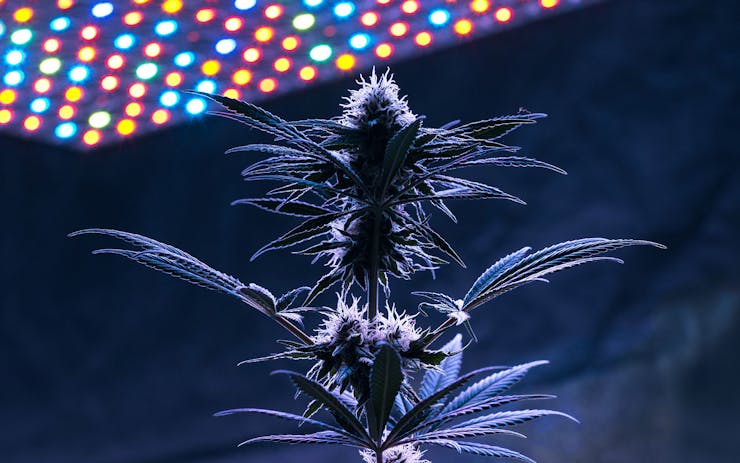Illinois legalized recreational cannabis in June 2019, and the environmental regulations it has put in place have made the state the national leader for environmental protection in the cannabis industry.
That’s good, because Illinois is also banning commercial growing outdoors, the first to do so statewide. While indoor growing has benefits—it allows minimal use of pesticide and better water preservation among other things—it’s much more of an energy drain than outdoor growing.
To minimize the impact, Illinois has set aggressive energy rules. They require cultivators to use energy-efficient lighting and HVAC equipment and to report their energy and water use on an annual basis.
Trying to be carbon neutral
Some stats on indoor growing:
- A typical 5,000-square-foot indoor cannabis cultivation facility uses 66 times more energy than the average US household.
- In 2018, cannabis cultivation accounted for 4% of Denver’s electricity consumption.
- Total electricity demand from legal marijuana cultivation in the United States is estimated to rise 162% by 2022.
Tenay Kham, Co-founder and Director of Cultivation of Butter, sees the environmental restrictions that Illinois has made as best practices that show industry input. But he thinks it will take time for the industry to really prioritize the environment.
A typical 5,000-square-foot indoor cannabis cultivation facility uses 66 times more energy than the average US household.
“Growing a company sustainably is often overlooked. The [priority] is trying to make a newly regulated industry run efficiently. This is unlikely to happen until the market matures and consolidation begins to demand efficient procedures. Every bit of education helps.”
Because of their massive energy use, indoor commercial cannabis cultivation facilities are unlikely to ever become carbon neutral. HPS (high-pressure sodium) lights, still the most popular kind of light used, can increase the temperature in a grow room by as much as 30°F, so heat, ventilation, and air conditioning (HVAC) systems have to be used to maintain a consistent temperature.
However, sustainably minded companies can dramatically lower their carbon footprint by installing equipment to produce clean energy onsite and wisely choosing what grow-room equipment to install.
According to Sam Milton, principal of Climate Resources Group: “We often see a difference of up to 50% between inefficiently operated grow facilities and top-performing ones. After savings from these smarter grow-room decisions, a grower can then purchase carbon offsets or renewable energy credits in order to further reduce their net carbon footprint. Not many growers have taken all of these steps.”
Carbon offsets represent the act of reducing greenhouse gases (GHG) in one place to “offset” an emission taking place somewhere else. Renewable energy certificates, or RECs, represent one megawatt hour (MWh) of energy generated from a clean, renewable source, such as wind, solar, hydro, or certain types of renewable biomass.
The importance of recording data
Reporting energy use is also crucial for keeping cultivators accountable and collecting data. Massachusetts requires annual reporting on their energy use, but there is still not enough high-quality data for the public to really know how growers there are performing.
Shop highly rated dispensaries near you
Showing you dispensaries nearThe lack of reliable data makes it difficult to base assessments of the likely consequences of large-scale indoor cultivation and production of cannabis. The impacts are therefore predicated on conditions and practices prevalent in illicit grow operations.
Given that the methods employed in illegal operations are driven by the need for secrecy, growing methods have not been optimized in the legal market to minimize environmental damage.
More data in cannabis agronomy and plant physiology, water preservation, and waste management would aid the new industry and relevant regulatory bodies in assessing the current environmental threats of cannabis cultivation and ways to mitigate such impacts.
How to make an indoor grow more green
Growers are a traditional bunch, but more and more cannabis consumers should demand sustainable products as the planet heats up. Outdoor growing may become more appealing as communities become more educated about cannabis and the environmental implications of indoor growing become clearer.
Nevertheless, there are ways to make homegrows and indoor commercial grows more sustainable, if not carbon neutral.
- LED lights use less energy than any other grow light to achieve comparable results, and the little heat generated by them doesn’t require an HVAC system. Many companies are developing technologies that can bring plants the best light quality at the lowest energy input.
- Combined heat and power (CHP) is an energy efficient technology that generates electricity and captures the heat that would otherwise be wasted to provide useful thermal energy—such as steam or hot water—that can be used for space heating, cooling, domestic hot water, and industrial processes. CHP is used in many other industries and typically has a 3 to 5 year payback. It also requires little time to set up and there are no grid limitations.
- There are a lot of exciting developments in the use of AI sensory controls that regulate the environment and collect data to help growers understand at a granular level which environmental conditions—light levels, humidity, temperature, nutrients, CO2, etc.—will produce the best yields. Sometimes, more inputs aren’t better.
- The different seasons of the year can have an impact on indoor operations. Natural solutions may be better for better climate control. You may be able to pump air directly into your grow from outside or use other methods to regulate your environment.
- Sustainability also includes water preservation—desalination and reverse osmosis systems can reclaim most of the water used during the growing process. The downside is that these technologies require an additional investment and maintenance. Collecting rainwater is also a great way to save water.





